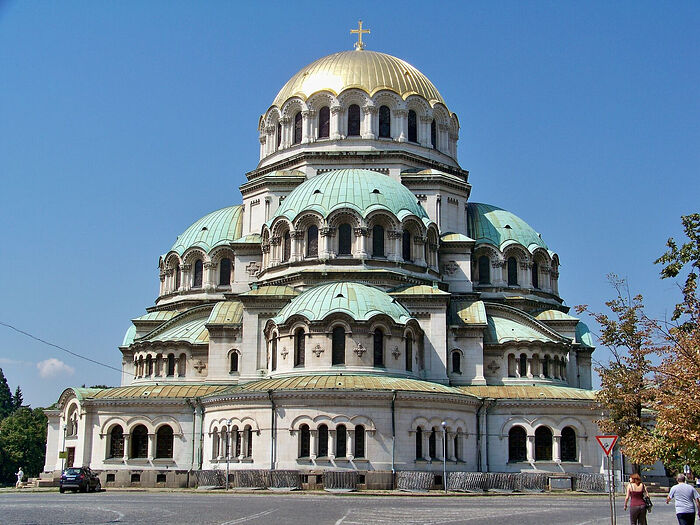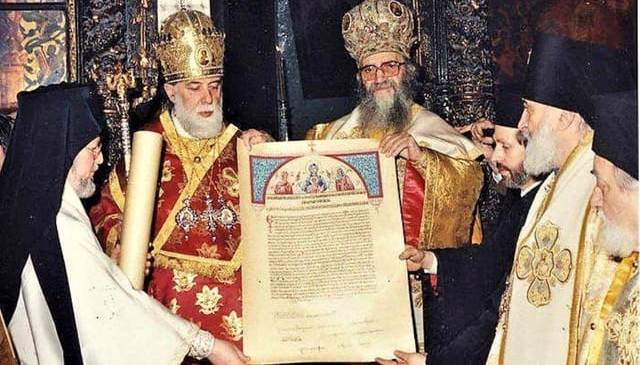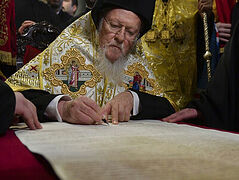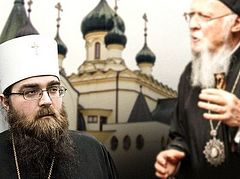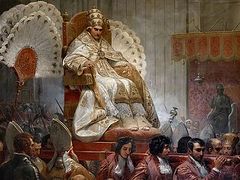We continue our analysis of the tomoi of autocephaly which have been granted by the Patriarchate of Constantinople. In part 2, we discuss the tomoi of the Bulgarian, Georgian, and Czech and Slovak Churches.
The Bulgarian Church
In 1945, after a seventy-three-year-long schism, the result of a difficult compromise came to fruition, and the Patriarchate of Constantinople recognized the autocephaly of the Bulgarian Orthodox Church (which was self-proclaimed in 1872), and issued a corresponding tomos. The added complexity of forming a compromise with an existing organization obviously made it difficult to limit its autocephaly. A significant place in the tomos is given to a historical emphasis on the role of the Patriarchate of Constantinople in the fate of Bulgarian Orthodoxy and the Bulgarian people. In particular, the tomos reads, “our Great Church gave birth in the Lord unto, and nurtured, the Bulgarian people.”
The centuries-old history of the Bulgarian Church, including two periods of its autocephaly and its Patriarchate, is ignored in the tomos.
“…We bless the autocephalous structure and administration of the Holy Church in Bulgaria, and also designate it as the Holy Orthodox Autocephalous Bulgarian Church, so that from now on it would be recognized as our spiritual sister; let it govern and institute its affairs independently and autocephalously in accordance with the order and sovereign rights of other Orthodox autocephalous Churches, recognizing as its supreme ecclesiastical authority the Holy Synod, which is formed of its hierarchs and whose primate is His Beatitude, the Metropolitan of Sofia and Exarch of All Bulgaria.
…on general ecclesiastical issues which require œcumenical (universal) discussion and study, let him defer with our Most Holy Patriarchal Ecumenical Throne, and ask and accept from it both its authoritative opinion and understanding,1 as well as the opinion and understanding of other Holy Sister Churches.”
Full text (in Russian): https://zen.yandex.ru/media/id/5f7848c5368d1f1e76d54697/tomos-ob-avtokefalii-bolgarskoi-pravoslavnoi-cerkvi-5f788aca71c44f0829221367
-
Despite the ancient traditions of the Patriarchate in the Bulgarian Church, its primate does not receive the patriarchal title.
-
The question of chrism is not raised in the tomos.
-
The monopoly of the Phanar on the moderation of the relations of the Bulgarian Church with other Local Churches is written into the tomos.2
-
The Bulgarian Church is declared a Sister Church of the Church of Constantinople.
The Georgian Church
In 1990, the Church of Constantinople issued another tomos on the recognition of autocephaly, which has possessed a duel interpretation. This is in reference to the autocephaly of the Georgian Orthodox Church, which first received it from the Patriarchate of Antioch in the fifth century, and which was confirmed in the eleventh century. The Georgian Church temporarily lost it in the nineteenth century under the Russian Empire, but after Georgia gained independence in 1917, it proclaimed its own autocephaly anew. Due to the unilateral nature of this renewal of autocephaly, it was initially not recognized by the Russian Orthodox Church at the Local Council of 1917, but at the next Council of Bishops in 1943, (which was assembled immediately after a relaxation of the persecution against Christians in the USSR), the autocephaly of the Georgian Church was recognized by Moscow.
Despite the undoubted historicity, canonicity and legitimacy of the autocephaly of the Georgian Church, the Phanar chose not to recognize it for another forty-seven years. One of the reasons for this was [their] doctrine of monopoly on the granting of autocephaly, which was already taking shape in the depths of the Church of Constantinople. And the situation with the Georgian Church was difficult to squeeze into the framework of this doctrine: the first autocephaly was received from Antioch and the second—from Moscow.
This posed a clear contradiction to these new teachings of the Phanar; in addition to that, this was concerning an ancient Church, already recognized in world Orthodoxy. It was impossible to portray that autocephaly was granted to her only from Constantinople, and that this happened recently, it was both a blatant lie, and [one which] would never have been supported in Georgia itself. The result of this complex puzzle was the Phanar's controversial tomos about the “recognition of autocephaly”—in Georgia, it is considered simply a belated recognition of autocephaly. But the text of the tomos allows Phanar to interpret it as granting autocephaly, which the speakers of Constantinople explicitly state in their interviews.
Certainly, however, given that it was concerning the ancient Georgian Church, it would be extremely difficult to try to curtail its rights by depriving it of its patriarchate, or limiting its autocephaly, which is why the tomos says:
The Holy Orthodox Church situated in the blessed land of the Caucasus—included today within the borders of the Republic of Georgia—endowed since ancient times with a system of self-government free from outside intervention and enjoying a corresponding ecclesiastical organization, having born- and continuing to bear—in the general affairs of the Church a rich and praiseworthy witness, and preserving the revealed truth and teaching of our Orthodox Church without compromising or damaging its integrity.
This Church desires today to enjoy canonicity in the management of her own affairs and to participate, along with all the holy Orthodox Churches, in the same bond of brotherly service. Thus, she has addressed herself on several occasions to our very holy Ecumenical, Apostolic and Patriarchal See, asking her to bless and officially approve her constitution of self-government, so that in this way she may be an inseparable part, like the branch of the divine grapevine, of the canonical group of local Orthodox Churches, thus continuing to contribute to the building up and growth of the body of Christ.
It is to this praiseworthy appeal and request that the Holy Synod surrounding us has responded with tender solicitude, making use of the canonical right and obligation belonging to our very holy Ecumenical See: to take care of the holy Orthodox Churches that find themselves in a state of need and to guide them—taking them by the hand according to the needs of their life in time—to autocephalous governance, those among the ecclesiastical administrations which, in the context of the current situation of Orthodoxy, have been worthy of claiming this dignity. We have thus decided, our humble person along with the very holy and very honorable metropolitans around us, brothers and dear concelebrants in the Holy Spirit, to accept with benevolence the appeal made by our sister the holy Orthodox Church of Georgia to the very holy Church of Constantinople, first see in the ecclesiastical order, and to grant our blessing, recognition and official approbation of the autocephaly and the independent organization of this Church, subject to the definitive decision of the future holy Ecumenical Council, which alone assures eternally and without prejudice for all unity in the faith and canonical ecclesiastical order of our holy Orthodox Church.
Consequently, we declare as a Synod in the Holy Spirit and proclaim the very holy Church of Georgia to belong as before—and to be considered as such—to the group of sister autocephalous Orthodox Churches, under her ancient constitution and organization of self-government; a constitution of organization also attested to by Balsamon, who writes, “(…) for they say that in the time of the very holy patriarch Peter of Antioch, the great City of God, a synodal settlement took place according to which the Church of Iberia would be free and autocephalous (…)” (Cf. Rhallis-Potlis, Syntagma ton theion kai ieron Kanonon, Athens 1852, vol. II, p. 172)3. In doing this, we assure her that, under the name of “holy autocephalous Church of all Georgia,” she will be known as our spiritual sister and that she will be able to govern and manage her own affairs in independence and autocephaly, according to the canonical order and rights in force among the other holy autocephalous Orthodox Churches, having as Leader and Head, our Lord, God and Savior Jesus Christ, recognizing and honoring as first in the canonical and ecclesiastical order our Ecumenical See and only knowing as her supreme ecclesiastical administrative authority the Holy Synod composed of the canonical Orthodox hierarchs of Georgia, a Synod presided over by the Archbishop of Mtskheta and Tbilisi and Catholicos of all Georgia…
With regard to the holy Chrism,4 it is appropriate that the established ecclesiastical order be respected so that through visible and invisible signs the uninterrupted unity of our holy Orthodox Church may be constituted for all—those who find themselves within the Church and those who are outside—proclaimed and assured.
We equally recommend that with regard to questions or points of contention of a more general ecclesiastical nature and, as such surpassing the limits of the jurisdiction of the particular autocephalous Churches, thus rending necessary a more general examination and a vote, the Archbishop of Mtskheta and Tbilisi and Catholicos of all Georgia addresses himself to our very holy Ecumenical and Patriarchal See, through which passes communion with each Orthodox episcopal see resting faithful to the word of truth and that he ask her and receive by her authoritative opinion and that of the other sister Churches.5
In this tomos we see:
-
The author avoids calling the Primate of the Georgian Church “patriarch”, but uses the title of Catholicos.
-
There is no attempt to intervene and regulate the foundational system of the Synod of the Georgian Church.
-
The Church of Georgia, like the rest of the Local Churches, is called “sister,” but at the same time, for the first time in the tomoi, an indication of the “supremacy” of Constantinople is used: “…recognizing and honoring as first in the canonical and ecclesiastical order our Ecumenical See and only knowing as her supreme ecclesiastical administrative authority…”
-
A reference to the monopoly of the Patriarchate of Constantinople in matters of moderation of interchurch relations is indicated in a relaxed manner: “We equally recommend…”
-
A direct requirement to receive myrrh [Chrism] from Constantinople is not indicated, but it is clearly hinted at6 in the text.
The Orthodox Church of the Czech and Slovak Lands
An analogous problem with the recognition of autocephaly by the other Churches was faced by the Phanar with regard to the Orthodox Church of the Czech Lands and Slovakia7. Orthodoxy was brought to Czechoslovakia by the ministers of the Russian Church in the nineteenth century.8 During the years of the Bolshevik persecution of Christianity, the Serbian Orthodox Church took over care of Orthodoxy in the Czech-Slovak region, and created the autonomous Czech Diocese, which, in 1948 was ceded to the Russian Orthodox Church of the Moscow Patriarchate.9 In parallel from 1923 to 1959, a diocese of the Church of Constantinople operated in the Czech Republic, which traditionally did not coordinate its actions with the Sister Churches previously operating on this territory. In 1951, the Czech-Slovak Church received autocephaly from the Moscow Patriarchate, which was not recognized by the Patriarchate of Constantinople. The issue of recognition stretched out over forty-seven years, after which in 1998 Constantinople issued its own tomos, nevertheless recognizing the Czech Church, but doing so on conditions which are significantly different from all previous historical precedents:
“Blessed is God, the Father of our Lord Jesus Christ, who blessed with the participation of His Divine and all-good will, so that the light of truth and His Holy Spirit would shine the Orthodox Faith on the territory of the blessed lands of Czechia and Slovakia. His precious Cross was erected here in the ninth century by the God-bearing and all-praised missionaries of the Divine Word—the holy “Apostles to the Slavs” Cyril and Methodius, who were called here by the then-prince of Great Moravia, and sent by the zealous God-bearer, Patriarch St. Photius the Great.10
Their work was to plant God's seed in the hearts of the blessed Czech, Slovak, Moravian and Carpathian peoples…11
Our holy and great Church of Christ, which is entrusted with the care of all the holy Churches of God, and which will never abandon a single of its children unprotected, and will not allow anyone else to do what he has no right to do, and which as the living Church—living the life of a higher life which was revealed by the Lord Who is risen from the grave—carrying her ministry, has endowed with the honor of autonomy the Local Holy Church in the Czech Lands and Slovakia—[which is] living in a free, sovereign and liberal state, [and] despite the fact that this Church is of small numbers—in the 1923 edition of the Patriarchal and Synodal Tomos. From that time to the present day, the Local Holy Orthodox Church in the Czech Lands and in Slovakia has existed in spite of some of its non-canonical actions, which we forgave in silence, knowing that everything that was carried out non-canonically and contrary to the rules and traditions of the One Holy Orthodox Church, was invalid from the beginning, is invalid, and even unto the ages will never be valid.
Our Mediocrity12 ([Our] Lowliness)13 together with the lords14, the most eminent metropolitans who make up the holy and sacred synod of the Holy Great Church of Christ, have resolved, bearing in mind and obeying the canonical precepts of the Holy Fathers, that everything which exists in the Barbarian lands, that is to say concerning all Christians who abide beyond the borders of the Holy Patriarchal and Autonomous Churches, only the Great Throne of New Rome is to have spiritual care—we have accepted the request of the Holy Synod of the Local autonomous Orthodox Church in the Czech Lands and Slovakia, appreciating the zeal for the Orthodox faith of both the clergy and laity, and by this patriarchal and synodal tomos, we elevate the growing strength of the Local Orthodox Church in these lands from autonomous to autocephalous status, and at the same time we establish the following necessary conditions, which the Holy and Sacred Patriarchal Synod, that surrounds us and has ruling authority, define for the sake of the observance of the Orthodox faith, good order and tradition, and on the other hand, for the successful growth and the glory of the newly formed autocephalous Orthodox Church…
The conditions are as follows:
A:
The highest administration of the local autocephalous church in the Czech Lands and Slovakia is the Holy Synod of diocesan hierarchs who take part in pastoral service. The hierarch who pastorally administers the Prague Diocese is now titled His Beatitude, the Archbishop of Prague and all the Czech Lands and Slovakia (according to the ancient tradition of archbishops who are the first to preside over the metropolitans of local churches, as is happening and well observed in Cyprus, Greece, Albania and elsewhere), and becomes the chairman of the Holy Synod and has the privileges which belong to the first hierarch of each Local Church according to the thirty-fourth Apostolic Canon. The other diocesan hierarchs taking part in pastoral ministry, i.e. those of Prešov, Michalov and Olomouc-Brno, are elevated to the dignity of metropolitans and their dioceses to metropolises. The Archbishop of Prague and all the Czech Lands and Slovakia may be elected from any of the hierarchs, or other worthy clergymen of the one autocephalic Church of the Czech Lands and Slovakia.
Every Metropolitan of Prešov is now titled “Exarch of Slovakia” and has the right to convene the most eminent metropolitans and other clerics of Slovakia to an ecclesiastical meeting, on matters which are determined by the Holy Synod of the autocephalous Church of the Czech Lands and Slovakia to be issues of purely local Slovak interest. The decisions of these meetings must be submitted for inspection and assessment to the Holy Synod of the one unified autocephalous church in the Czech Lands and Slovakia. The Most Blessed Archbishop of Prague and all the Czech Lands and Slovakia can do analogously, in order to better study and resolve the exclusive local problems of the Church in Czechia15. The Church in Czechia and Slovakia can, by means of synodal decisions which are canonically approved, establish new dioceses according to potential pastoral needs.
B:
According to the sacred canons, the Holy Synod is duly convened to deal with administrative issues at least twice a year in order to resolve pastoral dogmatic-canonical problems that may arise.
C:
The canonically elected and appointed most blessed archbishop, and other most eminent metropolitans remain in office for life, except for those who arbitrarily resign or fall canonically [under ban or sanctions due to violations].
D:
Deacons and priests are tried by courts of the second level; Hierarchs are tried by courts of the first level and for transgressions of their duties, they are tried according to sacred canons through canonically composed synodal courts, for which, with the approval of the Ecumenical Patriarch, hierarchs are invited exclusively from the jurisdiction of the Mother Church, that is to say, from the Ecumenical Throne. Hierarchs judged [guilty] can appeal to the Ecumenical Patriarch for a final decision.
<…>
F:
When the Most Blessed Archbishop of Prague and all Czechia and Slovakia serves, he commemorates “all Orthodox bishops” according to the order and sacred diptych of the Ecumenical Patriarchate, he thus remembers [in order] the blessed patriarchs and autocephalous archbishops and metropolitans. The most eminent metropolitans remember the Archbishop of Prague as the first among them during divine services. The Most Blessed Archbishop of Prague and all Czechia and Slovakia has the right to wear a white klobuk with a cross decorated with stones. The most eminent metropolitans wear a black klobuk, again with a cross decorated with stones.
G:
The Church of the Czech Lands and Slovakia receives holy myrrh from the Ecumenical Patriarchate as a sign of spiritual unity with the Mother Church.
H:
The main and primary mission of the Holy Synod is to preserve the purity of the Orthodox faith and communion in the Holy Spirit with the Ecumenical Patriarchate and other Orthodox Churches. At the same time, in the event of any misconduct, it has the right to appeal not only to the Holy Synod of the Ecumenical Patriarchate, but also to a larger and broadened synod convened for that purpose by the care and initiative of the Ecumenical Patriarchate.
I:
With regard to global issues and ecclesiastical issues that go beyond the scope of possibilities of Local autocephalous Churches, His Beatitude the Archbishop of Prague and all the Czech Lands and Slovakia should turn to our Holy Patriarchal Ecumenical Throne, which is in communion with all Orthodox dioceses which rightly proclaim the word of truth. The Ecumenical Patriarchate will ask their Sister Churches for their opinions and positions. On this, we canonically remind you of the existing tomos as fatherly advice: “Stand firm and hold the Orthodox tradition” as a pillar of dogmatic truth. Any time you don’t know something well, or you have doubts: Ask your father, and he will show you (Deut. 32:7). We say this not to unnecessarily elevate our opinions, but to humbly seek what is the will of the Lord and what is good and perfect. We bless the new autocephalous Local Orthodox Church of the Czech Lands and Slovakia, and with it, its honored primate, His Beatitude, the Archbishop of Prague and all of the Czech Lands and Slovakia, and with him the most eminent metropolitans and the honorable priesthood in Christ. We wish the priests of the Lord and the pious people a rich blessing from God and our Savior Jesus Christ and the whole Church strength and growth to the glory of Christ and the salvation of the world. [We wish] our blessed brothers, archbishops, priests, monks and Christ-loving people, all the blessings of the Lord, peace and joy and noble fruits in the struggle for Christ and His Orthodox Faith.16
The full Czech original text can be read here: http://sul-zeme.cz/12-ruzne/8-konstantinopolsky-tomos-z-roku-1998
The text of the tomos is indeed original, from its form and style to its content.
-
For the first time, the text of the tomos was divided into points [i.e. the conditions of autocephaly were clearly outlined in an alphabetized list] obviously, for a clearer focus of attention on each significant point.
-
The entire introductory part of the text is devoted to substantiating and justifying the rights of Constantinople to judge the fate of the Czech-Slovak Church.
-
For the first time, in addition to various forms of expression of Christian love and respect, there are also accusations against the Church—the addressee of the tomos. [They are accused of “non-canonical acts” without clarification—Trans.]
-
Unlike the tomos of the Georgian Church, also issued long after gaining autocephaly, there is no ambiguity in the text. The text clearly conveys its intended meaning: “There was no autocephaly before, there were non-canonical actions [in the Czech-Slovak Church], and only now, despite your guilt, we are granting you this autocephaly.” Those interested can compare the wording with the tomos of the Bulgarian Church, which also went through a long conflict with the Phanar, but its tomos has a completely different connotation and tone.
-
The tomos clearly sets out the structure and rules of the management organs [i.e. the Holy Synod, dioceses, and ecclesiastical courts], of the Czech-Slovak Church. The new autocephalous Church has no freedom in regulating its own governing bodies.
-
Even the vestments of hierarchs [their head-coverings, the color of the klobuk and the permitted decoration thereof—Trans.] are regulated and specified.
-
For the first time, the teaching of Constantinople’s perceived right of monopoly to nourish all the “barbarian lands,” that is to say, the entire Orthodox diaspora outside the borders of the “patriarchal and autonomous Churches” is reflected in the tomos. In the light of this formulation, the question of the position of non-autonomous, autocephalous Churches which do not have patriarchal status remains unclear: the Greek, Polish, Albanian, and the Czech-Slovak Church itself: Are they subordinate to Constantinople?
-
The Church of Constantinople is finally named and confirmed in the tomos precisely as the “Mother Church,” and not as a Sister Church.
-
The supreme court of appeal in the new autocephalous Church is not its own hierarchy, but the hierarchs of Constantinople. Thus, the mechanism of any intervention or meddling in the internal affairs of the Czech-Slovak Church by the Phanar is set in the document.
-
The reception of chrism from Constantinople is unambiguously fixed [on the grounds that it is the “Mother Church”, no less—Trans.]
-
As in many other tomoi, Constantinople’s monopoly on moderating the communication of the new autocephalic church with other Local Churches is spelled out in this tomos.
-
Within the tomos, “communion with the Ecumenical Patriarchate” is set up as the main raison d’être of the Holy Synod of the Czech-Slovak Church along with “preserving the purity of the Orthodox Faith.” The very wording makes it impossible for the Czech-Slovak Church to break off communication with the Phanar in the event of canonical or dogmatic disagreements, without giving rise to any reason to challenge its autocephaly.
-
Christ, as the Head of the Church, is not mentioned in the tomos.
In reality, the tomos of autocephaly, issued by the Church of Constantinople to the Czech-Slovak Church, ends the era of “limited autocephaly,” which began with the Greek Church and continued in the twentieth century.
This document, in actuality, begins a new era of “nominal autocephaly,” in which the number and qualities of the rights of supposedly independent autocephalic Churches are greater than those of autonomous Churches. The good news for the Czech Church is that she has a diplomatic alternative, in matters of communication with other Churches, in that she can rely on other tomoi. So, in Prague in 2012, celebrations were held in honor of the anniversary of the receipt of the tomos from the Moscow Patriarchate, which angered the Phanar, and forced the Czechs to justify themselves saying that it was only a festive Liturgy, and not a triumphal celebration. At the same time, the tomos received from the Russian Orthodox Church is undoubtedly more attractive for the Czech-Slovak Church, since it does not contain such restrictions.
To be continued.

